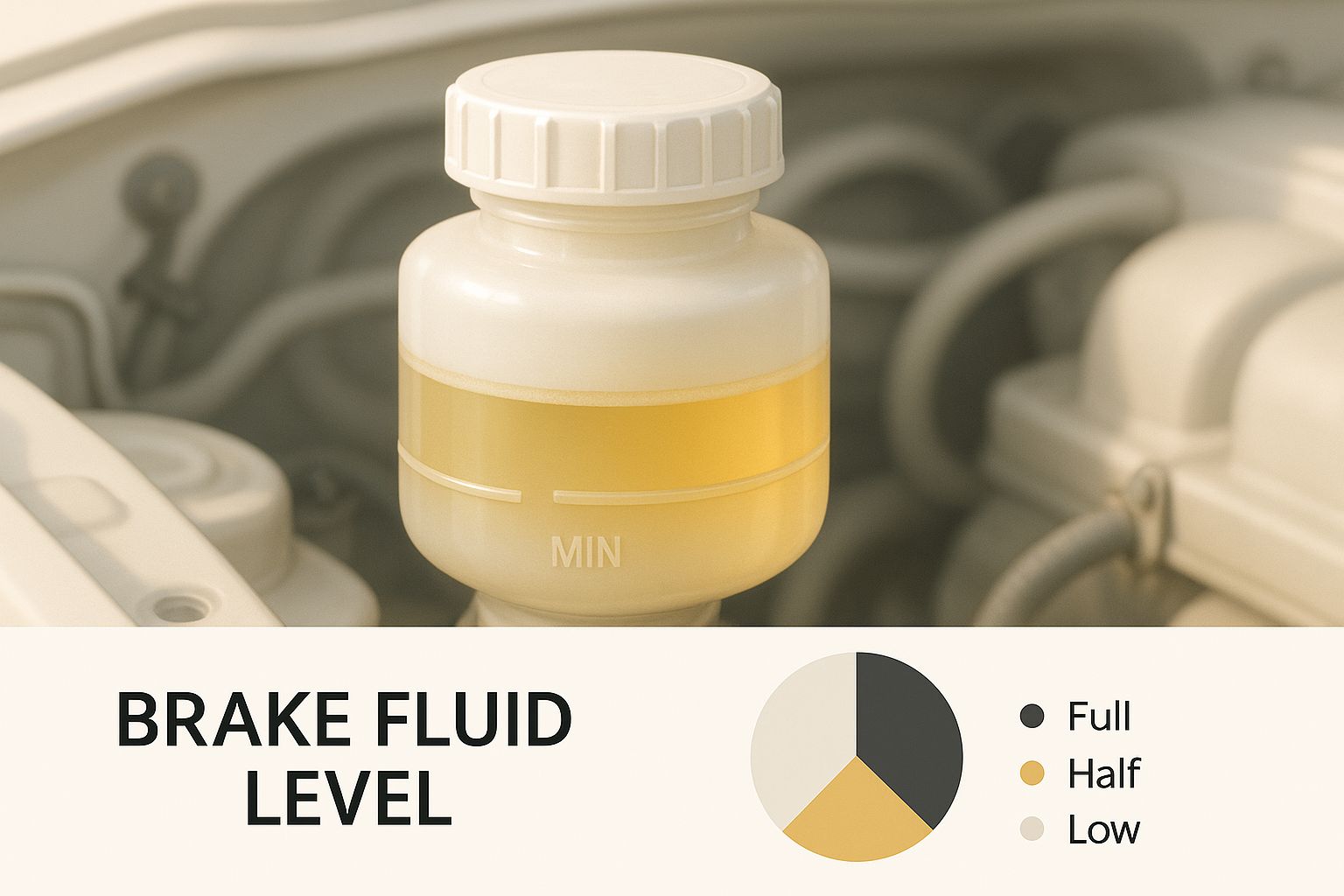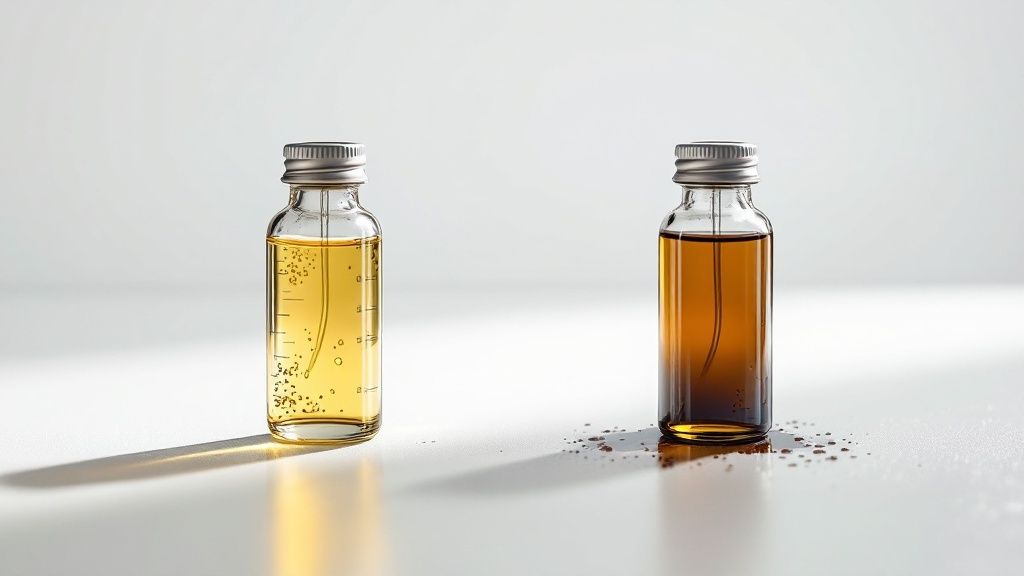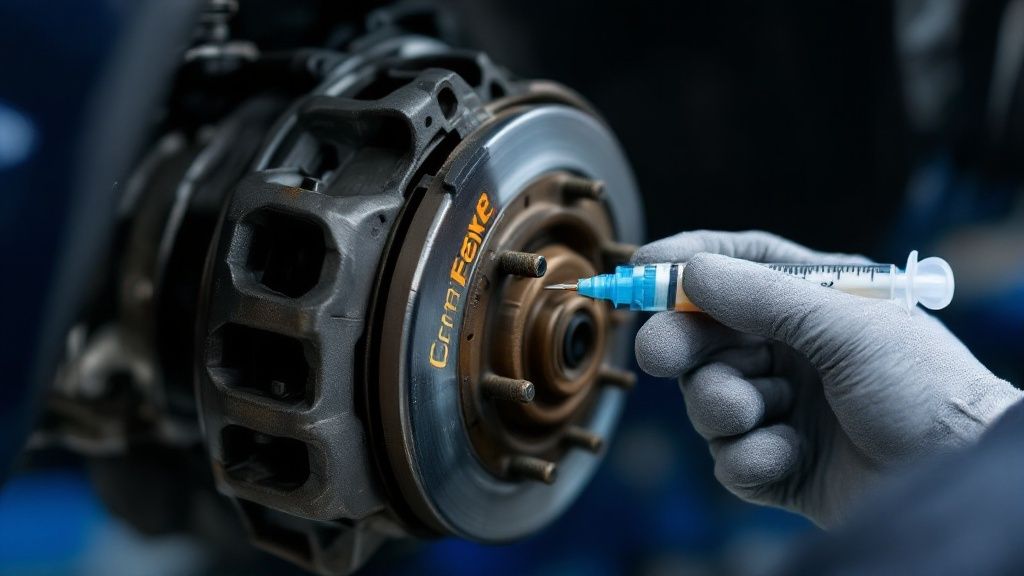The Hidden Hero: Why Your Brake Fluid Deserves Attention
Brake fluid isn't something we often think about. It's easy to forget about until there's a problem. However, this often-overlooked fluid is essential for your vehicle's safety, connecting your foot on the brake pedal to the actual stopping power of your brakes. This section explains why changing your brake fluid is a critical maintenance task, not just a suggestion.
Why Change It? The Science Behind Brake Fluid
Brake fluid operates within a hydraulic system, using fluid pressure to transmit force. Pressing the brake pedal sends force through the brake fluid to the brake calipers, which squeeze the brake rotors, slowing or stopping your wheels. However, brake fluid is hygroscopic, meaning it absorbs moisture from the air.
This moisture absorption is why changing your brake fluid is so crucial. Over time, absorbed water lowers the fluid's boiling point. Under heavy braking conditions, brake fluid can get very hot. If the boiling point is too low due to moisture, the fluid can vaporize, creating vapor lock. This vapor reduces braking performance, causing a soft brake pedal and potentially brake failure. You might be interested in: How to master your brakes.
The Importance of Regular Maintenance
Changing brake fluid is vital for vehicle safety. Since the introduction of hydraulic braking systems in 1918, brake fluid has been a key component. Manufacturers' recommendations have evolved over time, with many suggesting changes every two to three years or every 24,000 to 45,000 miles. More frequent changes may be needed in humid climates. According to Castrol, most manufacturers recommend changing brake fluid at least every two years for optimal performance and safety. Learn more about recommended brake fluid change intervals here.
Protecting Your Investment: Beyond Basic Safety
Brake fluid is crucial for your brake services. Beyond safety, neglecting fluid changes can lead to expensive repairs. Moisture-contaminated brake fluid can corrode vital components like the ABS module, calipers, and master cylinder. Regular changes protect these parts, extending their lifespan and saving you money.
This is especially important for those in areas with fluctuating climates, which can impact brake fluid effectiveness. Sticking to a regular maintenance schedule ensures a reliable and responsive braking system, even in challenging driving conditions.
The Silent Killer: Moisture's Impact on Your Braking System

This infographic showcases a car's brake fluid reservoir. The clear, golden fluid illustrates a healthy braking system, free from contaminants. A properly filled reservoir, as shown, is crucial for optimal braking performance. Regularly checking your brake fluid is paramount. Just like in the image, clean fluid should be a light, translucent color.
Any discoloration signals potential contamination and requires further inspection. Let's explore why this seemingly simple fluid deserves such careful attention.
How Moisture Sneaks In
Brake fluid inherently absorbs water molecules from the environment, even within a sealed system. This absorption occurs through microscopic gaps in seals and hoses. Over time, accumulated moisture becomes problematic. Like a sponge slowly absorbing water, even small amounts add up. This contamination gradually diminishes the fluid’s boiling point.
Under normal driving, brake fluid heats up. During hard braking, especially when descending hills or in emergencies, temperatures can rise dramatically. This is precisely why changing your brake fluid regularly is so critical.
The Dangers of Vapor Lock
If moisture-contaminated fluid reaches its lowered boiling point, it transforms into vapor. This vapor is compressible, unlike the incompressible liquid brake fluid essential for braking. This compressibility creates vapor lock. Imagine trying to stop your car by pushing on a pillow—it compresses, absorbing force without providing stopping power.
Water can infiltrate the braking system via condensation or faulty seals, reducing the fluid's boiling point and increasing the risk of vapor lock. This is more common in humid climates. In high-humidity areas, brake fluid checks might be needed more often. Even small amounts of moisture can drastically lower the boiling point, potentially causing safety hazards. Explore this topic further. Regular checks and fluid changes are essential to prevent these dangers.
To further illustrate this point, let's look at the impact of moisture on different brake fluid types.
The table below shows the effect of moisture contamination on the boiling point of various brake fluid types and the associated safety implications.
Effect of Moisture on Brake Fluid Boiling Points
| Brake Fluid Type | Dry Boiling Point (°F) | Wet Boiling Point (°F) | Boiling Point Reduction | Safety Implications |
|---|---|---|---|---|
| DOT 3 | 401 | 284 | 117 | Increased risk of vapor lock, reduced braking performance |
| DOT 4 | 446 | 311 | 135 | Increased risk of vapor lock, reduced braking performance |
| DOT 5 | 500 | N/A | N/A | DOT 5 is silicone-based and does not absorb water, however, it is not compatible with other DOT types. |
| DOT 5.1 | 518 | 375 | 143 | High performance, but still susceptible to moisture and requires regular changes. |
As the table clearly demonstrates, even a small amount of moisture can significantly lower the boiling point of brake fluid. This highlights the crucial need for regular fluid changes to maintain optimal braking system performance and safety.
Recognizing the Signs of Trouble
Moisture-contaminated brake fluid exhibits noticeable symptoms. A soft or spongy brake pedal is a primary indicator. Vapor in the brake lines compresses, reducing pedal firmness. You might also experience decreased braking responsiveness, increasing stopping distance. In severe cases, a grinding noise during braking might occur, signaling metal-on-metal contact and potential component damage from corrosion.
These warning signs necessitate immediate professional attention. Prompt action ensures safety and prevents further, more costly damage to your braking system.
What Manufacturers Won't Tell You About Brake Fluid Changes
Changing your brake fluid every two to three years is often presented as a standard guideline. However, various factors can influence how often your vehicle actually needs this vital service. Understanding these often-overlooked factors empowers you to make informed decisions about maintenance and safety.
Beyond the Standard: Factors Affecting Brake Fluid Lifespan
The typical two-to-three-year recommendation is a starting point. Your driving habits significantly influence your brake fluid's lifespan. Frequent hard braking generates heat, which accelerates moisture absorption in the brake fluid. If you often navigate stop-and-go traffic or mountainous terrain, more frequent changes might be necessary.
Climate also plays a role. High humidity contributes to faster moisture absorption, potentially requiring changes sooner than the standard two-year mark.
Vehicle design is another factor. High-performance vehicles or those with advanced braking systems may have specific requirements due to increased stress on the braking system. These nuances are often omitted from standard maintenance schedules.
Decoding the Fine Print: Time vs. Mileage
Most manufacturers emphasize a time-based interval, typically every two to three years, for brake fluid changes. This is because moisture absorption occurs over time, regardless of mileage. The global automotive industry stresses the importance of regular changes. Most recommendations fall within the two-to-three-year range, but this varies depending on factors like vehicle type and driving conditions.
In the UK, the recommendation is every two years or 24,000 miles, whichever comes first. Explore this topic further. This emphasizes the importance of time-based changes. A car driven infrequently can still accumulate moisture in its brake fluid, even if it hasn't reached a certain mileage. Adhering to the time-based recommendation is crucial, even for low-mileage vehicles.
Tailoring Your Approach: Daily Driver vs. Weekend Warrior
Your driving profile is key to determining your optimal brake fluid change schedule. A daily commuter in heavy traffic will likely need more frequent changes than a weekend driver.
Short trips can also be a factor. Brake fluid may not reach optimal temperatures to boil off accumulated moisture, potentially leading to faster degradation. Even for occasional drivers, sticking to the recommended time interval is crucial to prevent moisture buildup and maintain braking system integrity.
To help illustrate the varying recommendations, let's take a look at the following table:
Brake Fluid Change Recommendations by Manufacturer
This table provides a comparison of brake fluid maintenance intervals recommended by major vehicle manufacturers, demonstrating variations based on vehicle type and regional differences.
| Manufacturer | Recommended Interval (Years) | Mileage Interval | Special Conditions | Region-Specific Guidelines |
|---|---|---|---|---|
| Honda | 3 | – | Severe conditions: 1 year/12,000 miles | – |
| Toyota | 2 | – | Consult owner's manual for specific model | – |
| Ford | 2 | – | Driving in mountainous or hilly terrain: more frequent changes | – |
| BMW | 2 | – | High-performance models: consult owner's manual | Europe: every 2 years |
| General Motors | 2-3 | Consult owner's manual | Towing or heavy loads: more frequent changes | – |
Note: This table represents a sample and may not include all manufacturers or specific model recommendations. Always consult your owner's manual for the most accurate information for your vehicle.
As you can see, while the general guideline is around two years, specific recommendations can vary. Consulting your owner's manual is always the best way to ensure you're following the proper maintenance schedule for your vehicle. This tailored approach ensures your brake fluid changes align with your specific needs, maximizing safety and vehicle performance.
Red Flags: When Your Brake Fluid Is Crying for Help
Your vehicle often communicates subtly when its brake fluid needs changing. This section translates those quiet signals into clear warning signs. We'll explore visual cues, performance indicators, and dashboard warnings, helping you distinguish between routine maintenance and urgent issues.
Visual Inspection: What Your Brake Fluid's Color Reveals
One of the easiest ways to assess your brake fluid is with a quick visual check. Fresh brake fluid typically has a honey-amber color. Over time, as it absorbs moisture and degrades, the color will shift to a murky brown, resembling old motor oil. This discoloration is a clear sign of contamination and indicates it's time for a change. It's similar to checking the expiration date on food – a change in color often signals it's time for a replacement.

Performance Indicators: Feeling the Difference
Beyond visual cues, changes in brake performance can also indicate contaminated fluid. A spongy or soft brake pedal is a major red flag. This happens because the moisture in the fluid vaporizes under pressure, creating compressible gas that reduces braking force. Imagine trying to stop your car by pushing on a balloon – the pedal travels further with less resistance. You might also experience a delayed stopping response, meaning your car takes longer to stop than usual. This spongy feeling and delayed response can have serious safety implications, making a brake fluid change crucial.
Dashboard Warnings: Never Ignore the Lights
Modern vehicles often have dashboard warning lights specifically for brake system issues. The brake warning light can illuminate for various reasons, including low brake fluid, worn brake pads, or a malfunctioning ABS system. Never ignore this light. Some vehicles also have a dedicated ABS warning light. These lights are your car's way of telling you something needs attention. While topping off the fluid might temporarily resolve a low level, it's crucial to address the underlying cause. Just like treating a symptom without addressing the illness, simply adding more fluid without investigating a leak or contamination won't solve the problem long-term.
From Subtle Signals to Urgent Action: Interpreting the Signs
Recognizing these red flags can help you determine whether your brake fluid needs immediate attention or can wait for your next scheduled maintenance. A slight discoloration might warrant a professional inspection, while a spongy brake pedal requires immediate service. Master technicians can use specialized tools to test the moisture content of your brake fluid, providing a definitive assessment of its condition. This expertise is invaluable in differentiating between minor issues and critical problems requiring urgent attention. This proactive approach to maintenance protects not only your safety but also the health of your braking system, preventing potentially costly repairs in the future.
Become Your Own Brake Fluid Detective: The DIY Inspection
Understanding your car's brake fluid doesn't require a mechanic's certification. This guide empowers you to conduct simple checks at home between your regular service appointments at Kwik Kar. We'll walk you through the process, explaining the necessary tools and precautions for a safe and effective DIY inspection. This empowers you to stay informed about your vehicle's braking system and recognize when professional service is needed.
Locating and Accessing Your Brake Fluid Reservoir
First, you'll need to locate your brake fluid reservoir. It's typically a translucent plastic container situated near the firewall of your engine compartment. Your owner's manual will provide the precise location for your specific vehicle model. Before opening the reservoir, clean the cap and the surrounding area. This prevents dirt from contaminating the brake fluid during your inspection. This simple precaution is crucial, much like washing your hands before handling food.
Visual Inspection: Checking the Fluid's Condition
With the reservoir open, carefully examine the brake fluid. Fresh brake fluid usually has a light, honey-amber color. If the fluid appears dark brown or murky, it likely indicates excessive moisture and requires changing. This discoloration is a telltale sign of contamination and degradation. Also, check the fluid level. It should be between the minimum and maximum lines marked on the reservoir. A low fluid level could suggest a leak in the braking system, demanding immediate professional attention.
Using Moisture Test Strips: A Professional Touch at Home
For a more accurate moisture measurement, consider using brake fluid test strips. These strips are available online or at auto parts stores, and they change color based on the moisture content. Simply dip a strip into the fluid, following the manufacturer's instructions. The resulting color change corresponds to a moisture percentage, providing a more precise assessment than visual inspection alone. This extra information helps you determine if a fluid change is needed immediately or can wait until your next Kwik Kar service appointment. Our team can help interpret the results and advise on the best course of action.
Topping Off vs. Complete Fluid Change: Why It Matters
Low brake fluid might tempt you to simply add more. However, this rarely solves the underlying problem. Topping off old, contaminated fluid doesn't eliminate the existing moisture or contaminants; it merely dilutes them. This might temporarily improve the situation but doesn't address the root cause. It's like adding clean water to a dirty glass – it appears slightly cleaner but isn't truly clean. A complete fluid change, including a system flush, is necessary to remove all contaminated fluid and restore optimal braking performance. This procedure is best performed by the trained technicians at Kwik Kar, who have the necessary expertise and equipment to ensure your braking system is in peak condition, including using the correct type of brake fluid for your vehicle.
Knowing When to Seek Professional Help: The Limits of DIY
While DIY inspections are helpful, it's important to recognize their limitations. If you're unsure about any aspect of the inspection, or if you notice potential issues like discolored or low fluid, consult a qualified mechanic. Your brakes are a critical safety system. Don't hesitate to seek professional guidance from our team at Kwik Kar. We're here to provide the expertise and peace of mind you need for safe driving. Understanding the importance of brake fluid changes is key, and we can help determine the best course of action for your vehicle.
Behind the Scenes: What Actually Happens During a Brake Fluid Change

Changing your brake fluid isn't as simple as it might seem. It's more than just draining and refilling; it's a detailed process that requires professional expertise. Understanding this process highlights the importance of regular brake fluid changes and why professional service offers significant value.
More Than Just a Top-Off: The Complete Flush
Unlike other fluids that might just need a top-off, brake fluid requires a full system flush. This means removing all the old fluid from the brake lines, calipers, and master cylinder. Technicians use specialized tools to force clean fluid through the entire system, pushing out the old, contaminated fluid and any trapped air. This complete flush is vital because any remaining old fluid can reduce the effectiveness of the new fluid. It’s similar to cleaning a dirty glass – a quick rinse won't do; you need a thorough wash. If you're considering a DIY approach, a structured checklist like a commercial property inspection checklist can be a helpful guide for your own brake fluid inspection.
The Importance of Air Bleeding: Eliminating Hidden Dangers
Another critical step in a professional brake fluid change is bleeding the brakes. This process removes trapped air bubbles from the brake lines. Why is this important? Air is compressible, unlike brake fluid. This means that when you press the brake pedal, the air compresses instead of transmitting the force to the brakes, leading to a spongy pedal feel and reduced braking performance. In an emergency, this can be extremely dangerous. Imagine needing to stop quickly, but your brakes feel unresponsive due to air in the lines – the consequences could be severe.
Selecting the Right Fluid: DOT Matters
Brake fluids aren't all the same. They are classified by Department of Transportation (DOT) ratings, such as DOT 3, DOT 4, and DOT 5.1. Each type has a different boiling point and chemical composition. Using the incorrect fluid type can damage your braking system. For example, using DOT 3 when your car requires DOT 4 can lead to premature brake failure because of the lower boiling point. A qualified technician will always check your vehicle’s specifications to ensure the right fluid is used. For more details on fluid exchanges, check out this helpful article: fluid exchanges.
Time and Cost: What to Expect
A typical brake fluid change usually takes about 30 to 60 minutes. The cost typically ranges from $75 to $150, varying by vehicle type and location. While this might seem like a small expense, consider the potential cost of repairs resulting from neglecting this vital maintenance. Replacing a corroded ABS module or master cylinder can cost hundreds, even thousands, of dollars. The peace of mind from knowing your brakes are in excellent working order is priceless. Regular brake fluid changes are a cost-effective way to maintain vehicle safety and prevent expensive repairs.
The Payoff: Why Regular Brake Fluid Changes Save More Than Just Brakes
Regular brake fluid changes are essential for maintaining your vehicle's safety and performance. They are not just a routine maintenance item; they are an investment that can save you significant money and hassle in the long run.
Protecting Vital Components: A Cost-Benefit Analysis
Your brake system is a complex network of interconnected parts. When brake fluid becomes contaminated, it doesn't just affect the fluid itself; it corrodes vital components like ABS modules, calipers, and master cylinders. Replacing these parts can cost hundreds or even thousands of dollars.
A brake fluid change, on the other hand, is relatively inexpensive, usually costing between $75 and $150. This makes regular fluid changes a financially sound decision, preventing more substantial expenses later.
For instance, a small leak caused by corroded components might seem minor initially, but it can quickly escalate into a major repair. Regular brake fluid changes proactively protect these components from corrosion, reducing the risk of such costly failures.
Enhanced Performance: Consistent Pedal Feel and Reliable Stopping Power
Fresh brake fluid doesn't just protect your wallet; it also improves your driving experience. Well-maintained brake fluid ensures a consistent and firm brake pedal feel, giving you the confidence and control you need, particularly in emergencies.
Imagine needing to brake suddenly, only to discover a soft and unresponsive pedal due to contaminated fluid. This is a dangerous situation easily avoided with regular maintenance. Clean brake fluid also contributes to reliable emergency stopping power, ensuring your brakes perform as expected when you need them most.
Extending Vehicle Longevity: A Small Investment With Big Returns
Regular brake fluid changes contribute significantly to your vehicle's overall health and lifespan. By protecting critical components and maintaining optimal braking performance, you extend the life of your entire braking system. This proactive approach prevents premature wear and tear, keeping your vehicle reliable for years to come. Consider checking our guide on oil changes and other preventative maintenance.
Maintaining Resale Value: A Well-Documented Service History
A comprehensive service history, including regular brake fluid changes, can significantly increase your vehicle's resale value. Potential buyers see consistent maintenance as a sign of a well-cared-for car, making them more likely to pay a higher price. This makes regular maintenance a wise investment, benefiting both your current driving experience and your vehicle's future value.
Integrating Brake Fluid Maintenance Into Your Routine: Practical Advice
Making brake fluid changes a part of your regular vehicle maintenance is straightforward. Note the recommended change intervals on your calendar or set reminders on your phone. Tracking your service history in a notebook or app can also be helpful. This ensures you never overlook this vital service, keeping your braking system in optimal condition.
For all your automotive needs, including professional brake fluid changes, visit Kwik Kar Oil Change and Auto Care in Fort Worth, Texas. Our certified technicians offer reliable and transparent service, ensuring your vehicle receives the care it deserves.



